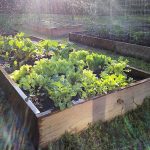Growing asparagus in the home garden has been a fun learning experience for us. I ordered asparagus “Jersey Knight” from the Burpee catalog – two-year-old crowns. I paid a lot more for them, but the promise is that the more mature asparagus crowns mean I can harvest some asparagus spears next year instead of waiting two years or more. At the rate my asparagus is growing, I’m wondering if it might not be sooner!
Growing Asparagus in the Home Garden
I chose asparagus Jersey Knight for its promised early harvest and disease resistance. While asparagus is a pretty hardy perennial vegetable, it can be subject to rust and fusarium root rot. Planting crowns purchased from a reputable nursery helps ensure disease-free rootstock. Good cultivation practices also prevent problems.
Growing Conditions for Asparagus
Asparagus like a rich, sandy loam soil, which for most of us in Virginia is the exact opposite of what we have. Most gardens around here are dealing with heavy clay to clay loam. Our solution to this problem is of course the raised beds we installed in the vegetable garden. We simply built the wooden raised beds and dumped in bags of topsoil, peat, compost (trucked in by a local company) and compost from the garden compost pile. The result is a well-drained rich soil that’s not exactly sandy loam, but a compost-rich loam that most of the vegetables plants seem to like.
The crowns came right on time from Burpee and we kept them in a cool, dark spot in the garage until ready to plan. We had to move all the herbs out of the herb bed first. I decided to move the herbs into the flower garden and around the edge of the clearing.
We lost more soil from that raised bed than we bargained for when we dug up the herbs, so we lost another day while Hubby ran out to Lowe’s for replacement soil. Several bags of soil later, we were ready to plant the crowns. We followed the directions carefully and spread out the roots, lining up the crowns to give the asparagus plenty of room. We just pulled up soil around the roots but left the crowns bare, and didn’t fill in more soil in the garden bed. We began a process of watering them daily.
10 Days from Planting to Growth
Within about 10 days, a few signs of life appeared, and we cheered the first airy fronds. Then they began sprouting in earnest! It looks like a weird alien bed with the asparagus fronds waving about.
As of today, 22 of the 24 asparagus crowns are alive and producing foliage. We added more soil once all of them appeared healthy, filling in the bed. We also placed a soaker hose around the asparagus, making U-shaped pins to hold the hose in place from old wire coat hangers. (The frugal gardener’s answers to expensive landscape pins.)
We are a long time away from harvesting the asparagus, but so far, so good. It’s fun to see them waving in the breeze and I can’t wait to watch their development!
More information on growing asparagus from the Virginia Cooperative Extension office.








I just planted Jersey Knight asparagus but have to wait longer as I just got the roots. They looked nice though and are all in the ground. I like the wispy asparagus plants. Can’t wait to have some fresh asparagus some spring.